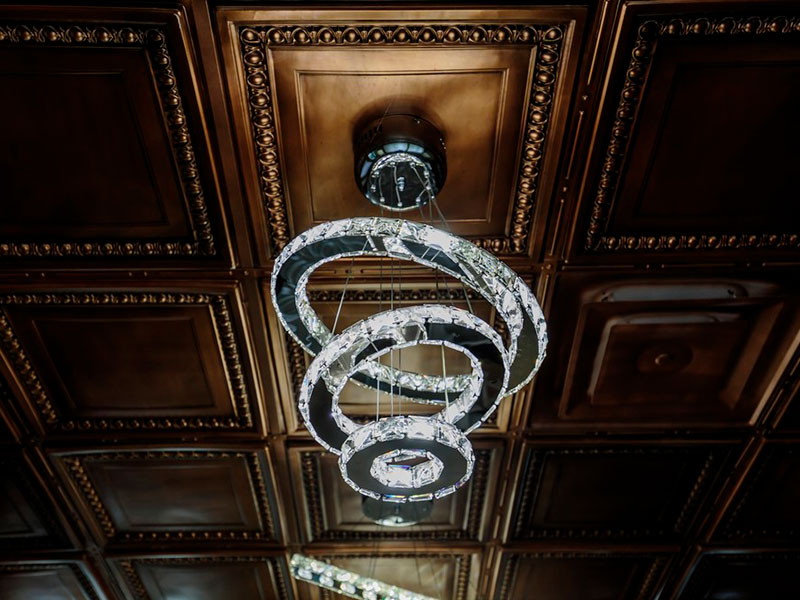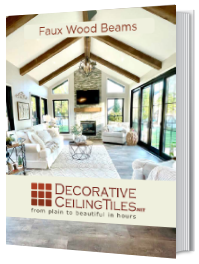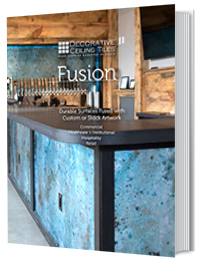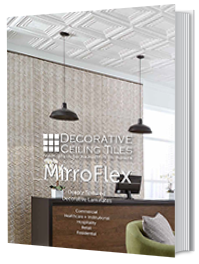Real Tin Ceiling Tiles vs Faux
Written by Milan Jara on 4th Mar 2022

There are many factors to consider when comparing real tin ceiling tiles to faux ones. What may appear to be an obvious choice may not benefit you in the long run.
When you compare real tin ceiling tiles to faux ones, the differences are stark, but not initially. At face value, faux tin ceiling tiles may be the way to go since they are more cost-effective. If you are looking for something that will last a long time, real tin ceiling panels are the only choice.
Benefits of Real Tin Ceiling Tiles
Originally, tin ceiling tiles were associated with older commercial buildings. They were made popular in the Victorian era because of their antique appeal. Now, more homeowners have incorporated them into their home design. Real tin ceiling tiles are eye-catching and offer an antique appearance suitable for any style of home.
The most popular variation is plain silver tin tiles. They are the least expensive, and their shine is eye-catching. Some have designs that are stamped on, adding a bit of culture to the space. They can be painted in any color but experts recommend that if you choose to paint them, use a high-gloss finish to maintain the shine.
Real tin ceiling tiles are popular because they are attractive. They come in a wide variety of textures and designs and are extremely versatile.
Additional benefits include:
- Added Value. These tiles increase the value of a home because they are durable. You can also customize the look according to your home as they come in stamped designs.
- Protect Against Fire and are Resistant to Heat. They work well in rooms with lighting, heating, and cooking, offering a safe barrier.
- Easy to Install. Installation is extremely straightforward, and you can do it as a DIY without any special tools. Most people use the nail-up method for installation.
- Practical. These tiles are non-porous and do not easily stain.
- Easy to Maintain. They only require an occasional surface clean or dusting to keep in top condition.
- Durable. Tin prevents moisture and dirt from accumulating and protects against rust, mold, floods, and fires. These tiles do not rot or crack and can strengthen a building and resist fire for up to one hour. These tiles can also last for up to 20 years.
- Retain Their Shape. Since they don’t crack, rot, or warp, tin ceiling tiles always retain their shape. They don’t peel, so your ceiling will not require frequent repairs.
- Sustainable. This material is extremely eco-friendly and non-toxic. Most are powder-coated, so you won’t have an issue with air quality.
- Great for Smaller Spaces. Tin reflects natural and artificial light. It allows the space to appear larger, making them perfect for small areas with no windows.
The only drawback to real tin tiles, when compared to PVC, is the price point. Costs add up as you need to prime the tiles first to avoid tarnishing. Many owners apply a tint to achieve antique looks in older homes.
Cutting the tin can be dangerous as well. Wear protective gloves to protect your fingers but be prepared to have the task become more complex. The tiles are more difficult to handle with thick gloves covering your hands.
Benefits of Faux Tin Ceiling Tiles
Faux tin ceiling tiles look like real tin but are plaster. This type of tile provides an easier-to-install and safer alternative to real tin ceiling tiles. They look real and provide a wonderful option when on a budget.
Faux tin ceiling tiles are easier to manage as you can directly apply them to the ceiling. They are lightweight and easier to cut and size for your area. They are also ideal for covering up imperfections and water stains.
Other benefits include:
- Available in Multiple Styles. Faux tin ceiling tiles can match any home decor.
- Easy to Install. They snap into place over your original ceiling. You can also glue them in place using paint and ceiling paper. This provides the look of a metal ceiling without added installation.
- Less Expensive. The up-front cost is significantly less than for real tin.
- Easy to Cut. Instead of needing to stop to cut a piece of tin (and the challenges that come with it), all you need to do is bend and snap the piece.
- Resists cracking. If you need to remove a tile, you can scrape it off between the tile and adhesive. It will remove itself without breaking off and leaving a mess.
While there are many benefits, there are detriments as well. They are cheaper initially, but faux tiles aren’t as durable as real tin. They are not as budget-friendly over time as real tin tiles.
What Are Your Material Options?

There are several options when it comes to materials for tin ceiling tiles. Steel is the most common. This material needs to be coated with polyurethane or paint to prevent rusting. Plating with copper or brass may eliminate the need for a topcoat.
Aluminum is half the weight of steel, so it is the lightest option, but it does need to be anodized or coated with paint or polyurethane to prevent corrosion. Meanwhile, stainless steel doesn’t require a coating, making it optimal for a kitchen backsplash, bathroom, or porch ceiling.

Copper is a nice touch if you are going for an antique appearance since it will naturally develop a patina. If you want it to remain shiny, apply a coat of polyurethane. This material is a natural choice for exterior use, backsplashes, and bathrooms with a great deal of humidity.
Alternatives to metal include mineral fiber and PVC. Mineral fiber consists of recycled newspapers, starch, and mineral wood. These tiles are tongue-and-groove and are installed with staples injected into furring strips. They are great at absorbing sound but are not designed for use in areas with high moisture.
PVC is very lightweight, and you can paint it to your preference. You can glue them in place or use a drop ceiling frame, and they won't stain. The drawback is that they will not withstand high heat.
What Types of Finishes Are Available?
For real tin ceiling tiles, your options are unfinished or a clear polyurethane/factory-applied paint finish. Some are additionally plated in metals like brass. For a faux tin ceiling tile, available finishes include painted (most realistic), copper (best for kitchen), Styrofoam, and exposed. Exposed finishes offer a thin layer of coat.
What is the Difference in Price Point?
As previously mentioned, real tin ceilings cost more than faux tin. In addition to the extra money spent on the real tin, users need to coat it with a protective material to prevent corrosion.
While this may seem like a detriment, over time, it is not. Once the tiles are protected, they last, so real tin tiles are actually a good investment. They resist almost anything – flood, fire, moisture, heat, rusting, and corrosion, and all you need to do is occasionally polish them.
They hide imperfections, and they resist staining. Real tin ceiling tiles add value to the home as well. They may be worth the investment because, over the long haul, they will outlast most other materials.
Meanwhile, while faux tin ceiling tiles are less expensive initially, they won’t stand up to wear as well as the real tiles. They are not as durable as time progresses, making them less cost-effective in the long run.
There are pros and cons to each method used. Real tin ceiling tiles are more expensive initially but are more durable and easier to maintain. There are numerous benefits to this type of tiling. Faux tin ceiling tiles are the most cost-efficient, but they don’t last as long. They are also prone to denting because they are extremely fragile.




